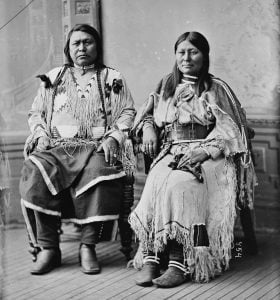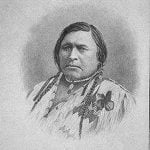
The Ute seldom visited Colorado City and the region round about in the early days, except in the winter, which was the only time they could do so with a fair degree of safety. A majority of the tribe had been on friendly terms with the English-speaking people from the time of their earliest contact with that race. It is true that straggling bands of Ute occasionally committed acts of depredation, and such bands on one or two occasions killed white people, but these acts were not approved by the majority of the tribe.
One of these exceptions occurred on Christmas day, 1854, at Fort Napesta, on the present site of the city of Pueblo. It is said that the men who occupied the fort were celebrating the day with the liquid that both cheers and inebriates, and in the midst of their jollity, a band of wandering Ute came by and was invited to join in the revelry. The Indians, nothing loath, partook of the white man’s Taos lightning, the product of a distillery at Taos, New Mexico, and the natural consequence was an attack upon the whites which resulted in all the latter being killed.
In 1866, a small, band of Ute began a raid upon the settlers on Huerfano Creek, but when the news reached Ouray, the head chief of the tribe, he sent runners out at once to warn the settlers and then went to the scene of action with a band of his faithful warriors. He soon afterwards took the hostile Indians prisoners and compelled them to go to Fort Garland and remain there, in this manner quickly ending the trouble. Ouray was always the friend of the whites, and is entitled to the very greatest credit for the able manner in which he held the Ute under control up to the time of his death, in 1881.
Ouray was born at Taos, New Mexico, in 1833. His father was a Tabeguache Ute and his mother a Jicarilla Apache. His boyhood was passed among the better class of Mexicans, chiefly as a herder of sheep. He learned Spanish and always preferred it to his native tongue. When eighteen years of age, he joined the band of Ute of which his father was leader, then located in southwestern Colorado. From that time until about 186o, he led the life of a wild Indian, passing his time hunting in the mountains and on the plains, varied by an occasional battle with the hereditary enemies of his people, the Kiowa, Sioux, Cheyenne, and Arapaho of the plains, in which he acquired the reputation of a courageous and skillful warrior. In 1859, he chose a wife, named Chipeta, from among the Tabaguache maidens, to whom he was always devotedly attached, and who bore him a son. This child was captured by the Cheyenne in 1863, they having surprised a hunting camp of Ute under Ouray’s command, near the present site of Fort Lupton on the Platte River. The boy was never recovered and, indeed, was never heard of afterwards.
In person Ouray was of the almost invariably short stature which distinguishes his people from those of the plains tribes. He stood about five feet seven inches high and in his later years became quite portly. His head was strikingly large and well-shaped, his features were regular, bearing an expression of dignity in repose, but lighting up pleasantly in conversation. In his ordinary bearing his manner was courtly and gentle, and he was extremely fond of meeting and conversing with cultivated white men, with whom he was a genial companion, compelling their respect and favor by the broad enlightenment of his views. In his habits he was a model, never using tobacco, abhorring whiskey, and taking only a sip of wine when in company with those who were indulging, and then merely as a matter of courtesy to them. He never swore nor used obscene language, was a firm believer in the Christian religion, and about two years before his death united himself with the Methodist Church.
When in active command of his men, his word was law, and disobedience meant death. In the summer of 1874 at Bijou, while returning from Denver to their camp in the south, one of his men decided to build a fire and started to cut some wood for that purpose within the enclosure of a white settler. Ouray, discovering his intention, ordered him back, reminding him that they must not trespass upon the property of the white man. The obstinate Ute replied that he must have firewood and that he would cut it anyway. Ouray answered that if he did, he would kill him, whereat the other observed that two could play at that game. Instantly both started for their guns, reaching them at about the same time, but Ouray was quicker than his adversary and shot him.
On another occasion he shot and broke the arm of Johnson, a member of his tribe, who afterwards caused much of the trouble at the White River Agency. Johnson was given to gambling, horse-racing, lying, and trickery of all kinds. In the present case, he had stolen some horses from white men, and refused to return them when commanded to do so, thereby, in Ouray’s opinion, bringing disgrace upon the Ute nation, for which he had to be punished.
In the foregoing, I have quoted freely from General Frank Hall’s History of Colorado. General Hall had unusual opportunities for knowing Ouray and of his dealings with the whites.

It was through the prompt and decisive action of Ouray that the leaders of the massacre of Meeker and others at the White River Agency, in 1879, were surrendered to the authorities for punishment. The early settlers of Colorado owe to Ouray a debt of gratitude, and a monument to his memory should at some time be erected by the people of this State. Ouray frequently came to Colorado City in the early days, and sometimes his visits were of considerable duration.
In the winter of 1865-1866, a large body of Ute Indians camped for several months on the south side of the Fountain, opposite Colorado City. On departing in the spring, they abandoned a squaw who had broken a leg, leaving her in a rudely constructed tent, or tepee. Had not the women of Colorado City taken her in charge she would have starved. After the Indians left, she was moved into a log cabin in Colorado City and provided with all she needed until her death, which occurred a few months later. The Ute seemed to think nothing of this heartless act, and even the abandoned squaw did not seem to resent it. It was a very common occurrence for the Indians of most of the tribes to abandon the aged and disabled, as in moving around, they did not wish to be burdened with those who were incapable of taking care of themselves.
In the winter of 1866-1867, a thousand or more Ute camped for several months below Manitou, between the Balanced Rock and the Fountain. Game was very scarce in this region during that winter and the Indians suffered for want of food. Finally, they reached such a strait that their chiefs made a demand upon the citizens of Colorado City for twenty sacks of flour, and intimated that unless it was produced forthwith, they would be compelled to march into town and take it by force. The citizens, realizing their utter helplessness in the matter, obtained the flour without delay and turned it over to the Indians. This was the only time in all the early period that Colorado City suffered from the presence of the Ute.
Chaveno and Colorow were the principal chiefs of this band. Chaveno was an Indian of a good deal of intelligence. When visiting the whites he always went about dressed in an army officer’s uniform of dark blue which had been given him by an officer at Fort Garland. Chaveno was always strutting around, and seemed very proud of him-self in his uniform, of which he took the greatest possible care. In the matter of dress, Colorow was the reverse. He seemed to have no liking whatever for the white man’s costume. His physique was like that of Ouray, short, but of powerful build. He had been a noted warrior in his early days and delighted in telling of his exploits in the various battles with the Cheyenne and Arapaho in which he had taken part. Colorow was treacherous by nature and his friend-ship for the whites was not always to be depended upon.
In the winter of 1874-1875, Ouray, with a band of six hundred Ute, camped at Florissant for several months. One day a Mr. Marksberry, living on Tarryall Creek, rode up to the Post Office at Florissant, tied his horse, and went into the building. The pony attracted the attention of an Indian named Antelope, who claimed the animal as his own; he slipped off the saddle and bridle, and, jumping on the pony’s back, rode away. Marksberry and a friend, being determined to recover the pony, followed the band to their camp in Beaver Park, south of Pike’s Peak. Marksberry found his pony with the Indian herd, caught it, and was turning away, when Antelope, hidden behind a tree, shot and instantly killed him. Chief Ouray, always ready to “travel the white man’s road,” gave up Antelope to justice. Upon trial of the case in the courts of Arapahoe County, some months later, he was acquitted.
The Ute, by treaties made in March, 1868, April, 1874, and March, 1880, ceded to the general government all the lands claimed by them within the boundaries of the present State of Colorado, except a small reservation retained for their own use in the southwestern part of the State.
